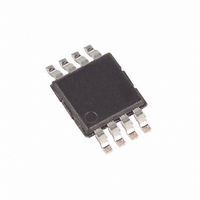DS1825U+ Maxim Integrated Products, DS1825U+ Datasheet - Page 10

DS1825U+
Manufacturer Part Number
DS1825U+
Description
IC THERMOMETER DIGITAL 8-USOP
Manufacturer
Maxim Integrated Products
Datasheet
1.DS1825U.pdf
(21 pages)
Specifications of DS1825U+
Function
Thermometer, Thermostat
Topology
Register Bank, Scratchpad
Sensor Type
Internal
Sensing Temperature
-55°C ~ 125°C
Output Type
Digital
Output Alarm
Yes
Output Fan
No
Voltage - Supply
3 V ~ 3.7 V
Operating Temperature
-55°C ~ 125°C
Mounting Type
Surface Mount
Package / Case
8-MSOP, Micro8™, 8-uMAX, 8-uSOP,
Temperature Threshold
Programmable
Full Temp Accuracy
+/- 0.5 C
Digital Output - Bus Interface
1-Wire
Digital Output - Number Of Bits
9 bit to 12 bit
Supply Voltage (max)
3.7 V
Supply Voltage (min)
3 V
Maximum Operating Temperature
+ 125 C
Minimum Operating Temperature
- 55 C
Supply Current
1.5 mA
Ic Output Type
Digital
Sensing Accuracy Range
± 0.5°C
Supply Voltage Range
3V To 3.7V
Resolution (bits)
12bit
Sensor Case Style
µSOP
No. Of Pins
8
Accuracy %
0.5°C
Rohs Compliant
Yes
Lead Free Status / RoHS Status
Lead free / RoHS Compliant
HARDWARE CONFIGURATION
The 1-Wire bus has by definition only a single data line. Each device (master or slave) interfaces to the data line
through an open-drain or 3-state port. This allows each device to “release” the data line when the device is not
transmitting data so the bus is available for use by another device. The 1-Wire port of the DS1825 (the DQ pin) is
open drain with an internal circuit equivalent to that shown in Figure 10.
The 1-Wire bus requires an external pullup resistor of approximately 5kW; thus, the idle state for the 1-Wire bus is
high. If for any reason a transaction needs to be suspended, the bus MUST be left in the idle state if the transaction
is to resume. Infinite recovery time can occur between bits so long as the 1-Wire bus is in the inactive (high) state
during the recovery period. If the bus is held low for more than 480ms, all components on the bus will be reset.
Figure 10. HARDWARE CONFIGURATION
TRANSACTION SEQUENCE
The transaction sequence for accessing the DS1825 is as follows:
Step 1. Initialization
Step 2. ROM Command (followed by any required data exchange)
Step 3. DS1825 Function Command (followed by any required data exchange)
It is very important to follow this sequence every time the DS1825 is accessed, as the DS1825 will not respond if
any steps in the sequence are missing or out of order. Exceptions to this rule are the Search ROM [F0h] and Alarm
Search [ECh] commands. After issuing either of these ROM commands, the master must return to Step 1 in the
sequence.
INITIALIZATION
All transactions on the 1-Wire bus begin with an initialization sequence. The initialization sequence consists of a
reset pulse transmitted by the bus master followed by presence pulse(s) transmitted by the slave(s). The presence
pulse lets the bus master know that slave devices (such as the DS1825) are on the bus and are ready to operate.
Timing for the reset and presence pulses is detailed in the 1-Wire SIGNALING section.
ROM COMMANDS
After the bus master has detected a presence pulse, it can issue a ROM command. These commands operate on
the unique 64-bit ROM codes of each slave device and allow the master to single out a specific device if many are
present on the 1-Wire bus. These commands also allow the master to determine how many and what types of
devices are present on the bus or if any device has experienced an alarm condition. There are five ROM
commands, and each command is 8 bits long. The master device must issue an appropriate ROM command
before issuing a DS1825 function command. A flowchart for operation of the ROM commands is shown in Figure
11.
T
R
V
PU
4.7K
R
RECEIVE
T
TRANSMIT
X
X
=
=
1-Wire Bus
10 of 21
DQ
Pin
µA
5
DS1825 1-WIRE PORT
MOSFET
100W
T
R











